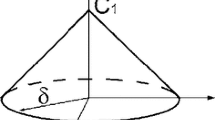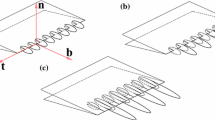Abstract
The behavior of fractures in 2D brittle disordered materials results from the competition between the microstructural disorder that roughens cracks and the material elasticity that straightens them. The experimental fracture surfaces left behind are generally scale invariant and their complex geometry are still largely unexplained. Here, this issue is addressed numerically using the boundary element method that predicts incrementally the trajectory followed by cracks in an infinite elastic medium with a heterogeneous field of fracture energy. The predicted fracture profiles are characterized using their height-height correlation function and show scale invariant properties. In particular, simulated cracks are shown to follow a random walk with roughness exponent \(\zeta = 0.5\), irrespective of the level of microstructural disorder, indicating that the crack behavior is neither persistent nor anti-persistent, but instead, that the orientation of the next propagation increment is chosen randomly, independently of the past trajectory. This behavior is then interpreted from fracture mechanics calculations that show that the restoring force emerging from elasticity that generally straightens cracks vanishes in the limit of large specimens with respect to the characteristic size of the material heterogeneity. Our findings shed light on some experimental fracture patterns recently reported and suggests an explanation for the observation of two different types of fracture morphologies in 2D disordered brittle solids.










Similar content being viewed by others
Notes
The development of \(G(\theta )/G_\mathrm {c}(\theta ) \simeq 1 - \cos ^2(\theta ) + \varDelta a/d \, f(\theta )\) around small angles \(\theta \ll 1\) for a continuous variation of \(G_\mathrm {c}\) shows that the limit \(\varDelta a/d \rightarrow 0\) corresponds to a straight path as the crack propagation direction along which this ratio is maximal converges then to \(\theta _\mathrm {max} \rightarrow 0\).
References
Alava MJ, Nukala PK, Zapperi S (2006) Statistical models of fracture. Adv Phys 55:349–476
Albertini G, Lebihain M, Hild F, Ponson L, Kammer DS (2021) Effective toughness of heterogeneous materials with rate-dependent fracture energy. Phys. Rev. Lett. 127:035501
Amestoy M, Leblond JB (1992) Crack paths in plane situations-II. Detailed form of the expansion of the stress intensity factors. Int J Solids Struct 29:465–501
Auvray N, Negi N, Trancart S, Ponson L (2019) L’analyse statistique des faciès de rupture: la science de la donnée au service de l’analyse de défaillance. Traitements & Matériaux 489:47–50
Barak Y, Srivastava A, Osovski S (2019) Correlating fracture toughness and fracture surface roughness via correlation length. Int J Fract 219:19–30
Ben-Dayan I, Bouchbinder E, Procaccia I (2006) Random and correlated roughening in slow fracture by damage nucleation. Phys Rev E 74:146102
Boffa JM, Allain C, Hulin JP (1998) Experimental analysis of fracture rugosity in granular and compact rocks. Eur Phys J Appl Phys 2:281–289
Bonamy D, Bouchaud E (2011) Failure of heterogeneous materials: a dynamic phase transition? Phys Rep 498:1–44
Bonamy D, Ponson L, Prades S, Bouchaud E, Guillot C (2006) Scaling exponents for fracture surfaces in homogeneous glass and glassy ceramics. Phys Rev Lett 97:135504
Bouchaud E, Lapasset G, Planès J (1990) Fractal dimension of fractured surfaces: a universal value? Europhys Lett 13:73–79
Bouchbinder E, Mathiesen J, Procaccia I (2004) Roughening of fracture surfaces: the role of plastic deformation. Phys Rev Lett 92:245505
Bouchbinder E, Procaccia I, Santucci S, Vanel L (2006) Fracture surfaces as multiscaling graphs. Phys Rev Lett 96:055509
Cambonie T, Bares J, Hattali ML, Bonamy D, Lazarus V, Auradou H (2015) Effect of the porosity on the fracture surface roughness of sintered materials: from anisotropic to isotropic self-affine scaling. Phys Rev E 91:012406
Chambolle A, Francfort GA, Marigo JJ (2009) When and how do cracks propagate. J Mech Phys Solids 57:1614–1622
Cotterell B, Rice JR (1980) Slightly curved or kinked cracks. Int J Fract 16:155–169
Crouch S (1967) Solution of plane elasticity problems by the displacement discontinuity method. Int J Numer Methods Eng 10:301–343
Crouch S, Starfield A (1983) Boundary element methods in solid mechanics. Georges Allen and Unwin, London
Dalmas D, Lelarge A, Vandembroucq D (2008) Crack propagation through phase-separated glasses: effect of the characteristic size of disorder. Phys Rev Lett 101:255501
Demery V, Rosso A, Ponson L (2014) From microstructural features to effective toughness in disordered brittle solids. EPL 105:34003
Engøy T, Måløy KJ, Hansen A, Roux S (1994) Roughness of two-dimensional cracks in wood. Phys Rev Lett 73:834–837
Erdogan F, Sih G (1963) On the crack extension in plates under plane loading and transverse shear. J Basic Eng 85:519–525
Faber KT, Evans AG (1983) Crack deflection processes-I. Theory. Acta Metall 31:565–576
Gol’dstein RV, Salganik RL (1974) Brittle fracture of solids with arbitrary cracks. Int. J. Fract 10:507–523
Hakim V, Karma A (2009) Laws of crack motion and phase-field models of fracture. J. Mech. Phys. Solids 57:342–368
Hansen A, Hinrichsen E, Roux S (1991) Roughness of crack interfaces. Phys. Rev. Lett. 66:2476–2479
Hansen A, Schmittbuhl J (2003) Origin of the universal roughness exponent of brittle fracture surfaces: stress weighted percolation in the damage zone. Phys Rev Lett 90:45504
Hussain MA, Pu SL, Underwood J (1974) Strain energy release rate for a crack under combined mode I and mode II. ASTM Spec Tech Publ 560:2–28
Katzav E, Adda-Bedia M (2013) Stability and roughness of tensile cracks in disordered materials. Phys Rev E 882088:052402
Katzav E, Adda-Bedia M, Derrida B (2007) Fracture surfaces of heterogeneous materials: a 2d solvable model. Eur Phys Lett 78:46006
Kertesz J, Horvath V, Weber F (1993) Self-affine rupture lines in paper sheet. Fractals 1:67–74
Lebihain M (2019) Large-scale crack propagation in heterogeneous materials : an insight into the homogenization of brittle fracture properties. Ph.D. thesis. Sorbonne Université
Lebihain M, Leblond J, Ponson L (2020) Effective toughness of periodic heterogeneous materials: the effect of out-of-plane excursions of cracks. J Mech Phys Solids 11:137
Mallick M, Cortet PP, Santucci S, Roux SG, Vanel L (2007) Discrepancy between sub-critical and fast rupture roughness: a cumulant analysis. Phys Rev Lett 98:255502
Måløy KJ, Hansen A, Hinrichsen EL, Roux S (1992) Experimental measurements of the roughness of brittle cracks. Phys Rev Lett 68:213–215
Mandelbrot BB, Passoja DE, Paullay AJ (1984) Fractal character of fracture surfaces of metals. Nature 308:721–722
Melin S (1985) The infinitesimal kink. Report LUTFD2/(TFHF-3022)/1-19, Division of solid Mechanics, Lund Institute of Tchnology
Meng C, Maerten F, Pollard DD (2013) Modeling mixed-mode fracture propagation in isotropic elastic three dimensional solid. Int J Fract 179:45–57
Millman VY, Stelmashenko NA, Blumenfeld R (1994) Fracture surfaces: a critical review of fractal studies and a novel morphological analysis of scanning tunneling microscopy measurements. Prog Mat Sci 38:425–474
Morel S, Bonamy D, Ponson L, Bouchaud E (2008) Transient damage spreading and anomalous scaling in moratr crack surfaces. Phys Rev E 78:016112
Morel S, Lubet T, Pouchou JL, Olive JM (2004) Roughness analysis of the cracked surfaces of a face centered cubic alloy. Phys Rev Lett 93:065504
Ortiz JE, Cisilino AP (2005) Boundary element method for j-integral and stress intensity factor computations in three-dimensional interface cracks. Int J Fract 133:197–222
Osovski S, Srivastava A, Ponson L, Bouchaud E, Tvergaard V, Ravi-Chandar K, Needleman A (2015) The effect of loading rate on ductile fracture toughness and fracture surface roughness. J Mech Phys Solids 76:20–46
Patinet S, Vandembroucq D, Roux S (2013) Quantitative prediction of effective toughness at random heterogeneous interfaces. Phys Rev Lett 110:165507
Ponson L (2007) Crack propagation in disordered materials: How to decipher fracture surfaces. Ann Phys 32:1–128
Ponson L (2016) Statistical aspects in crack growth phenomena: how the fluctuations reveal the failure mechanisms. Int J Frac 201:11–27
Ponson L, Auradou H, Vié P, Hulin JP (2006a) Low self-affine exponents of fractured glass ceramics surfaces. Phys Rev Lett 97:125501
Ponson L, Bonamy D, Bouchaud E (2006b) Two-dimensional scaling properties of experimental fracture surfaces. Phys Rev Lett 96:035506
Ponson L, Shabir Z, Abdulmajid M, der Giessen EV, Simone A (2021) A unified scenario for the morphology of crack paths in two-dimensional disordered solids. Phys Rev E (in press)
Ramanathan S, Ertas D, Fisher DS (1997) Quasistatic crack propagation in heterogeneous media. Phys Rev Lett 79:873–876
Ramos O, Cortet PP, Ciliberto S, Vanel L (2013) Experimental study of the effect of disorder on subcritical crack growth dynamics. Phys Rev Lett 110:165506
Salminen LI, Alava M, Niskanen KJ (2003) Analysis of long crack lines in paper webs. Eur Phys J B 2003:369–374
Schwaab ME, Biben T, Santucci S, Gravouil A, Vanel L (2018) Interacting cracks obey a multiscale attractive to repulsive transition. Phys. Rev. Lett. 120:255501
Shen B, Stephansson O (1994) Modification of the g-criterion for crack propagation subjected to compression. Eng Fract Mech 47:117–189
Silva GD, Einstein HH (2013) Modeling of crack initiation, propagation and coalescence in rocks. Int. J. Fract 182:167–186
Srivastava A, Ponson L, Osovski S, Bouchaud E, Tvergaard V, Needleman A (2014) Effect of inclusion density on ductile fracture toughness and roughness. J Mech Phys Solids 63:62–79
Vernède S, Ponson L (2015) Method for characterizing the cracking mechanism of a material from the fracture surface thereof , patent WO050871
Vernède S, Ponson L, Bouchaud J (2015) Turbulent fracture surfaces: a footprint of damage percolation? Phys Rev Lett 114:215501
Wang N, Xia S (2017) Cohesive fracture of elastically heterogeneous materials: an integrative modeling and experimental study. J Mech Phys Solids 98:87–105
Williams ML (1952) Stress singularity resulting from various boundary conditions in angular corners of plates in extension. J Appl Mech 19:526–528
Zapperi S, Nukala PK, Simunovic S (2005) Crack roughness and avalanche precursors in the random fuse model. Phys Rev E 71:026106
Author information
Authors and Affiliations
Corresponding author
Additional information
Publisher's Note
Springer Nature remains neutral with regard to jurisdictional claims in published maps and institutional affiliations.
Rights and permissions
About this article
Cite this article
Konate, L., Kondo, D. & Ponson, L. Numerical fracture mechanics based prediction for the roughening of brittle cracks in 2D disordered solids. Int J Fract 230, 225–240 (2021). https://doi.org/10.1007/s10704-021-00576-1
Received:
Accepted:
Published:
Issue Date:
DOI: https://doi.org/10.1007/s10704-021-00576-1




